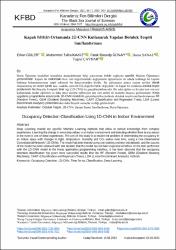| dc.contributor.author | Güler, Erkan | |
| dc.contributor.author | Kakız, Muhammet Talha | |
| dc.contributor.author | Günay, Faruk Baturalp | |
| dc.contributor.author | Şanal, Burcu | |
| dc.contributor.author | Çavdar, Tuğrul | |
| dc.date.accessioned | 2023-10-16T05:31:54Z | |
| dc.date.available | 2023-10-16T05:31:54Z | |
| dc.date.issued | 2023 | en_US |
| dc.identifier.citation | Güler, E., Kakız, M.T., Günay, B., Şanal, B. & Çavdar, T. (2023). Kapalı Mekân Ortamında 1D-CNN Kullanarak Yapılan Doluluk Tespiti Sınıflandırması. Karadeniz Fen Bilimleri Dergisi, 13(1), 60-71. https://doi.org/10.31466/kfbd.1162332 | en_US |
| dc.identifier.issn | 2564-7377 | |
| dc.identifier.uri | https://doi.org/10.31466/kfbd.1162332 | |
| dc.identifier.uri | https://hdl.handle.net/11436/8499 | |
| dc.description.abstract | Derin Öğrenme modelleri kompleks deneyimlerden bilgi çıkarımına imkân sağlayan spesifik Makine Öğrenmesi
yöntemleridir. Kapalı bir mekândaki bazı veri değerlerindeki değişiminin öğrenilmesi ile odada herhangi bir kişinin
bulunup bulunmamasının tespit edilmesi bu deneyimlerden biridir. Bu çalışmanın amacı zaman serileri olarak
oluşturulmuş ve zaman içinde ışık, sıcaklık, nem ve CO2 değerlerindeki değişimler ile kapalı bir mekânda doluluk tespiti
probleminin Bir Boyutlu Evrişimli Sinir Ağı (1D-CNN) ile gerçekleştirilmesidir. Bir adet eğitim ve iki adet test veri seti
kullanılarak model eğitilmiş ve daha önce tecrübe edilmeyen test veri setleri ile modelin başarısı gözlenmiştir. Keras
uygulama programlama arayüzünde 1D-CNN modeli ile gerçekleştirilen testlerde doluluk tespiti sınıflandırmasının RF
(Random Forest), GBM (Gradient Boosting Machines), CART (Classification and Regression Trees), LDA (Linear
Discriminant Analysis) yöntemlerinden daha başarılı sonuçlar verdiği gözlenmiştir. | en_US |
| dc.description.abstract | Deep Learning models are specific Machine Learning methods that allow to extract knowledge from complex
experiences. Learning the change in some data values in an indoor environment and detecting whether there is any person
in the room is one of these experiences. The aim of this study is to realize the problem of determining the occupancy in
an indoor space with changes in light, temperature, humidity and CO2 values over time, using a One-Dimensional
Convolutional Network (1D-CNN). The model has been trained using one training and two test datasets, and the success
of the model has been observed with test datasets that the model has not been experienced before. In the tests performed
with the 1D-CNN model in the Keras application programming interface, it has been observed that the occupancy
detection classification has given more successful results than the RF (Random Forest), GBM (Gradient Boosting
Machines), CART (Classification and Regression Trees), LDA (Linear Discriminant Analysis) methods. | en_US |
| dc.language.iso | tur | en_US |
| dc.publisher | Giresun Üniversitesi | en_US |
| dc.rights | info:eu-repo/semantics/openAccess | en_US |
| dc.subject | Doluluk tespiti | en_US |
| dc.subject | 1D-CNN | en_US |
| dc.subject | Zaman serisi | en_US |
| dc.subject | Sınıflandırma | en_US |
| dc.subject | Derin öğrenme | en_US |
| dc.subject | Occupancy detection | en_US |
| dc.subject | Time series | en_US |
| dc.subject | Classification | en_US |
| dc.subject | Deep learning | en_US |
| dc.title | Kapalı mekân ortamında 1D-CNN kullanarak yapılan doluluk tespiti sınıflandırması | en_US |
| dc.title.alternative | Occupancy detection classification using 1D-CNN in indoor environment | en_US |
| dc.type | article | en_US |
| dc.contributor.department | RTEÜ, Teknik Bilimler Meslek Yüksekokulu, Elektronik ve Otomasyon Bölümü | en_US |
| dc.contributor.institutionauthor | Şanal, Burcu | |
| dc.identifier.doi | 10.31466/kfbd.1162332 | en_US |
| dc.identifier.doi | 10.31466/kfbd.1162332 | en_US |
| dc.identifier.volume | 13 | en_US |
| dc.identifier.issue | 1 | en_US |
| dc.identifier.startpage | 60 | en_US |
| dc.identifier.endpage | 71 | en_US |
| dc.relation.journal | Karadeniz Fen Bilimleri Dergisi | en_US |
| dc.relation.publicationcategory | Makale - Ulusal Hakemli Dergi - Kurum Öğretim Elemanı | en_US |


















